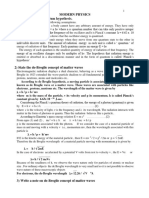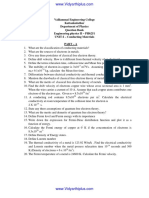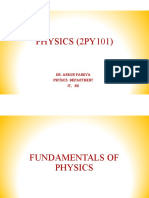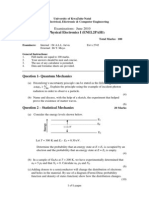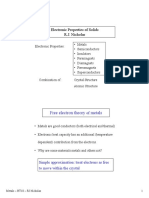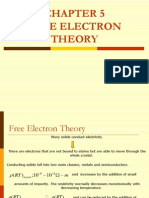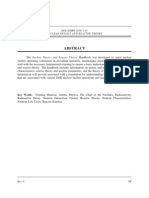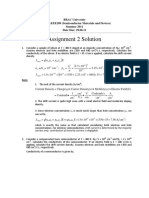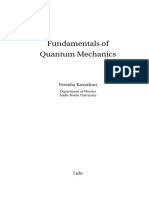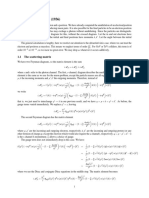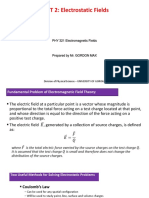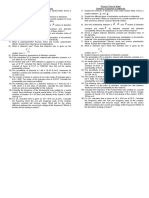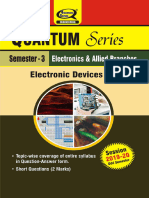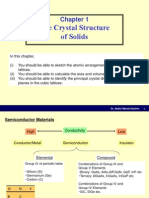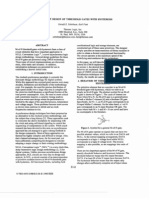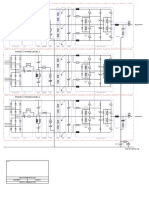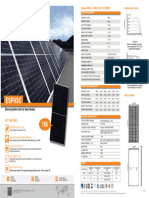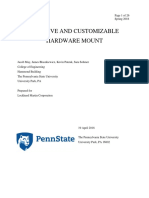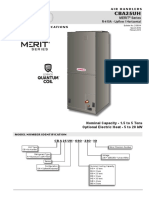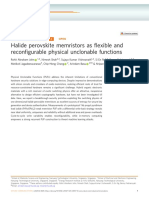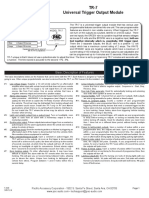Microelectronics I
Chapter 2: Introduction to Quantum Mechanics
2.1 Principles of Quantum Mechanics 2.2 Schrodingers Wave Equation 2.3 Applications of Schrodingers Wave equation 2.4 Extensions of the Wave Theory to Atoms
�Microelectronics I : Chapter 2
Introduction 1
Control electron in the solid (crystal) Position Velocity devices speed No. of electron
Current, I
nxqxv
velocity
Density of electron
Need to know electron behavior in the crystal and the material (energy band, etc)
Introduction of quantum mechanics (Defines electron with wave function) Schrodinger equation
�Microelectronics I : Chapter 2
Introduction 2
Quantum mechanic becomes more significant as electronic device becomes smaller Appearance of quantum effect Current, I
Electron channel
Width, W I
Voltage, V
Smaller W Ohms law classical V
I ? V
Here, classical Physics no longer applicable !!
�Microelectronics I : Chapter 2
Objective:
To understand the basic of quantum mechanics Wave-particle duality Schrodinger equation - equation - physical meaning Application: -quantized energy -tunneling effect
Chapter 3: energy band theory of solids
�Microelectronics I : Chapter 2
light
propagates as wave (frequency, ) Interference Refraction diffraction Particle having energy, h *h, Planck's constant = 6.625 x 10-34 Js 1905, Einstein Photon (discrete packet)
Explains the photoelectric effect
Max kinetic energy of photoelectron
light
photoelectron
o Wave-Particle duality
frequency
�Microelectronics I : Chapter 2 Wave-Particle duality of electron Electron: charged particle (q=1.6 x 10-19 C) ex:
Inxqxv
De Broglie (1924) Particle with momentum, p has wavelength,
Wave nature
= h/p
Ex:
e
P: Plancks constant
Velocity, v=105 m/s = h/p =h/m.v =6.625 x 10-34/(105 x 9.11 x 10-31) = 7.27 nm
�Microelectronics I : Chapter 2 Wave-particle duality : experiment
Double slit Electron gun
e
screen
When electron hits the screen, a dot will appears Particle nature
Shoot electron 4 times
Double slit screen 1st Electron gun
e
4th 2nd 3rd
Electron could go through the slit Position of electron was random
�Microelectronics I : Chapter 2 Shoot electron many time
slit Electron gun
e
http://www.hitachi.com/rd/research/em/doubleslit.html
screen
slit
screen
a: 8 electrons, b: 270 electrons, c: 2000 electrons, d: 160,000 electrons Interference pattern Wave nature
�Microelectronics I : Chapter 2 Interpretations
1. Electron propagates in space like wave 2. Each electron pass through both two open slit at the same time 3. Electron interfere with itself
Double slit screen
Electron gun
e e
The experimental results confirm the wave-particle duality of electron
�Microelectronics I : Chapter 2 The Uncertainty principle (Heisenberg 1927)
Impossible to simultaneously describe with absolute accuracy the position and momentum of a particle
px
p: uncertainty in momentum x : uncertainty in position
Impossible to simultaneously describe with absolute accuracy the energy of
particle and the instant of time the particle has this energy
Et E: uncertainty in energy t : uncertainty in time Cannot determine exact position of electron use probability
�Microelectronics I : Chapter 2 Schrodinger Wave Equation
Describe and discuss electron behavior
Wave function
sin, cos
k : wave number : angular momentum : initial phase
(x,t)= a.cos(kx-t+))
Use exp exp(j)=cos+jsin
(x,t)= exp ( j(kx-t)) = exp( jkx)exp(-jt) (x,t)= (t)(x)
=0
time-dependent position-dependent
�Microelectronics I : Chapter 2 Schrodinger Wave Equation2 Time-independent Schrodinger equation H(x)=E(x)
Hamiltonian Energy of electron
Hamiltonian: total energy operator H = kinetic energy + potential energy
h2 2 H = + V ( x) 2 2m x
h2 2 2m x 2 + V ( x) ( x) = E ( x)
�Microelectronics I : Chapter 2 Physical meaning of wave equation (x): wave function |(x)|2: probability of existence of electron at x position of electron cannot be determined precisely
2 * | ( x ) | dx = ( x) ( x)dx = 1
*(x): complex conjugate function
total probability=1
�Microelectronics I : Chapter 2 Major quantities: energy, momentum, position of electron
H ( x) h Momentum, ( x) i x Position, x ( x )
Energy,
Result :equation
Value of major quantities given by expected value in probability theory energy
+
+
momentum
* ( x)
* ( x)H ( x)dx * ( x) ( x)dx
h ( x)dx i x
position
* ( x)x ( x)dx * ( x) ( x)dx
* ( x) ( x)dx
Result :real number
�Microelectronics I : Chapter 2 Boundary Condition Region I Region II
x=a Condition 1: (x) must be finite, single-valued, and continuous Condition 2: (x)/x must be finite, single-valued and continuous
I (a ) = II (a) I II
x
x=a
Condition 1
x=a
Condition 2
�Microelectronics I : Chapter 2 Basic solution of Schrodinger equation
Consider V: constant
h2 2 2m x 2 + V ( x) = E ( x)
--eq.1
2 ( x) 2m(V E ) ( x) = 0 2 2 x h
constant
Second order differential equation
�Microelectronics I : Chapter 2 1. if, E < V
2m(V E ) 2 = >0 2 h
eq.1
" 2 = 0 " = 2
Solution:
= Ae x + Be x
A,B: Coefficient
Condition 1( must be finite)
= Be x
�Microelectronics I : Chapter 2 1. if, E > V
2m(V E ) 2 = >0 2 h
eq.1
" + 2 = 0 " = 2
Solution:
= Ce i x + De i x
C,D: Coefficient
Wave function is given by the combination of the two type solution
�Microelectronics I : Chapter 2 Application 1: Potential well
region I
region I and III
region II region III
V(x)= Electron cannot exist in the regions
x=0
x=L
=0
region II (0<x<L)
2 ( x) 2m(V E ) ( x) = 0 2 2 x h
V=0
Time-independent equation
2 ( x) 2mE + 2 ( x) = 0 ---eq. 1 2 x h
�Microelectronics I : Chapter 2 eq. 1
2 ( x) 2mE = ( x) 2 2 x h
=
Solution ;
"
2mE = 2 h
2
= Ae i x + Be i x
Boundary condition;
I ( 0 ) = II ( 0 ) = 0
II ( L ) = III ( L ) = 0
A+B =0
...eq. 2
Ae i L + Be i L = 0
...eq. 3
�Microelectronics I : Chapter 2 From eq. 2 & 3
A ( e i L e i L ) = 0
A0
e e =0 i 2 sin( L ) = 0
i L
i L
region II
En=3 En=2 En=1 x=0 x=L
L = n
2 mE L = n h
n; integer
h 2 E = n 2m L
2
The energy of particle is quantized Particular discrete values Classical; continuous values
�Microelectronics I : Chapter 2 Wave function
= Ae i x + Be i x
n = 2 iA sin x L n = C sin x L
normalization
n C sin x dx = 1 L 0
2 2
Total probability=1
C =
2 L
2 n sin x L L
n=1,2,3,4
�Microelectronics I : Chapter 2
x=L Wave functions
x=L Corresponding probability functions
�Microelectronics I : Chapter 2 Application 2: Potential well
region I region II region III
V0 e Region I
x=0 Region II
x=L
2 I ( x) 2mE + 2 I ( x) = 0 2 x h
Region III
2 II ( x) 2m(V0 E ) II ( x) = 0 2 2 x h
2 III ( x) 2mE + 2 III ( x) = 0 2 x h
�Microelectronics I : Chapter 2 Consider E<V0,
2mE 2m(V0 E ) 2 = , = 2 2 h h
2
Solution; wave function
I = Ae + Be x II = Ce + De
i x
i x
region I
region II
region III
V0 A C E
III = Ee i x + Fe i x
B F=0 x=0 D x=L F
III = Ee i x
�Microelectronics I : Chapter 2 Boundary condition;
I (0) = II (0) II ( L) = III ( L)
Continuous wave function
4 equation
I (0) = II (0) II ( L) = III ( L)
' '
'
'
Continuous first derivative
Can solve for the 4 coefficients B, C, D, E in term of A
�Microelectronics I : Chapter 2 Parameter of interest; Transmission coefficient, T
region I region II region III
V0 A E
E E* T= A A*
x=0
x=L
E E T 16 V 1 V exp(2 L) 0 0
T is not zero Electron penetrate the barrier
tunneling
�Microelectronics I : Chapter 2
L Wave function through the potential barrier
�Microelectronics I : Chapter 2 Extensions of the wave Theory to Atoms Potential function (coulomb attraction)
+
Nucleus; positively charged
e2 V (r ) = 4 0 r
approximation
Expected results
=
Quantized energy
2 n x sin L L
+
Quantum well
+
Quantum well
n=1,2,3,
�Microelectronics I : Chapter 2 Solving Schrodinger equation
2m0 (r , , ) + 2 ( E V (r )) (r , , ) = 0 h
2
Wave function & energy of electron in the atom result
m0 e 4 1 En = 2 2 2 (4 0 ) 2h n
n; 1, 2, 3, (principal quantum number)
1. Energy of atom is quantized. The value is determined by a quantum number,n 2. Wave function of electron also determined by quantum numbers (n, l, m)
�Microelectronics I : Chapter 2 Quantum states of electron Quantum number n: principal quantum number (determine total electron energy) N=1, 2, 3,. l: azimuthal quantum number (specifies the shape of atomic orbital) l= n-1, n-2,,0 (s,p,d,..) m: magnetic quantum number ( direction) |m|=l,l-1,0 s: spin quantum number ( spin of electron) S=1/2, -1/2
y
S- orbital
z z y x z y x y
p- orbital
z x x
�Microelectronics I : Chapter 2 electron energy ex: C (no. of electron: 14) n=2
l=2s m l=1s n=1
l=2p
n=2
n=1
As n increases, energy of quantum state increases
Pauli Exclusion Principle No two electrons may occupy the same quantum state
